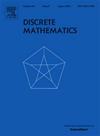关于极大匹配多项式的根
IF 0.7
3区 数学
Q2 MATHEMATICS
引用次数: 0
摘要
让 mk(G) 表示 G 中大小为 k 的最大匹配数。G 的最大匹配多项式定义为 m(G;x)=∑kmk(G)xk。众所周知,最大匹配多项式概括了众所周知的匹配多项式,因为每个图的匹配多项式都可以从另一些图的最大匹配多项式得到。虽然匹配多项式的根已经得到了广泛的研究和很好的理解,但对最大匹配多项式的根的研究还没有发展起来。在本文中,我们将研究这些多项式根的位置。我们证明了路径和循环的最大匹配多项式只有实数根,并为它们的根提供了交错关系。另一方面,与匹配多项式不同,最大匹配多项式可以有非实根,我们提供了最大匹配多项式有非实根的无限图族。本文章由计算机程序翻译,如有差异,请以英文原文为准。
On the roots of maximal matching polynomials
A maximal matching of a graph G is a matching of G which is not properly contained in any other matching of G. Let be the number of maximal matchings of size k in G. The maximal matching polynomial of G is defined by . It is known that maximal matching polynomials generalize the well-known matching polynomials, as the matching polynomial of every graph can be obtained from the maximal matching polynomial of some other graph. While the roots of matching polynomials have been extensively studied and well understood, the study of the roots of maximal matching polynomials has not been developed. In this article, we study the location of the roots of these polynomials. We show that maximal matching polynomials of paths and cycles have only real roots, and provide interlacing relations for their roots. On the other hand, unlike matching polynomials, maximal matching polynomials can have non-real roots, and we provide an infinite family of graphs whose maximal matching polynomials have non-real roots.
求助全文
通过发布文献求助,成功后即可免费获取论文全文。
去求助
来源期刊

Discrete Mathematics
数学-数学
CiteScore
1.50
自引率
12.50%
发文量
424
审稿时长
6 months
期刊介绍:
Discrete Mathematics provides a common forum for significant research in many areas of discrete mathematics and combinatorics. Among the fields covered by Discrete Mathematics are graph and hypergraph theory, enumeration, coding theory, block designs, the combinatorics of partially ordered sets, extremal set theory, matroid theory, algebraic combinatorics, discrete geometry, matrices, and discrete probability theory.
Items in the journal include research articles (Contributions or Notes, depending on length) and survey/expository articles (Perspectives). Efforts are made to process the submission of Notes (short articles) quickly. The Perspectives section features expository articles accessible to a broad audience that cast new light or present unifying points of view on well-known or insufficiently-known topics.
 求助内容:
求助内容: 应助结果提醒方式:
应助结果提醒方式:


